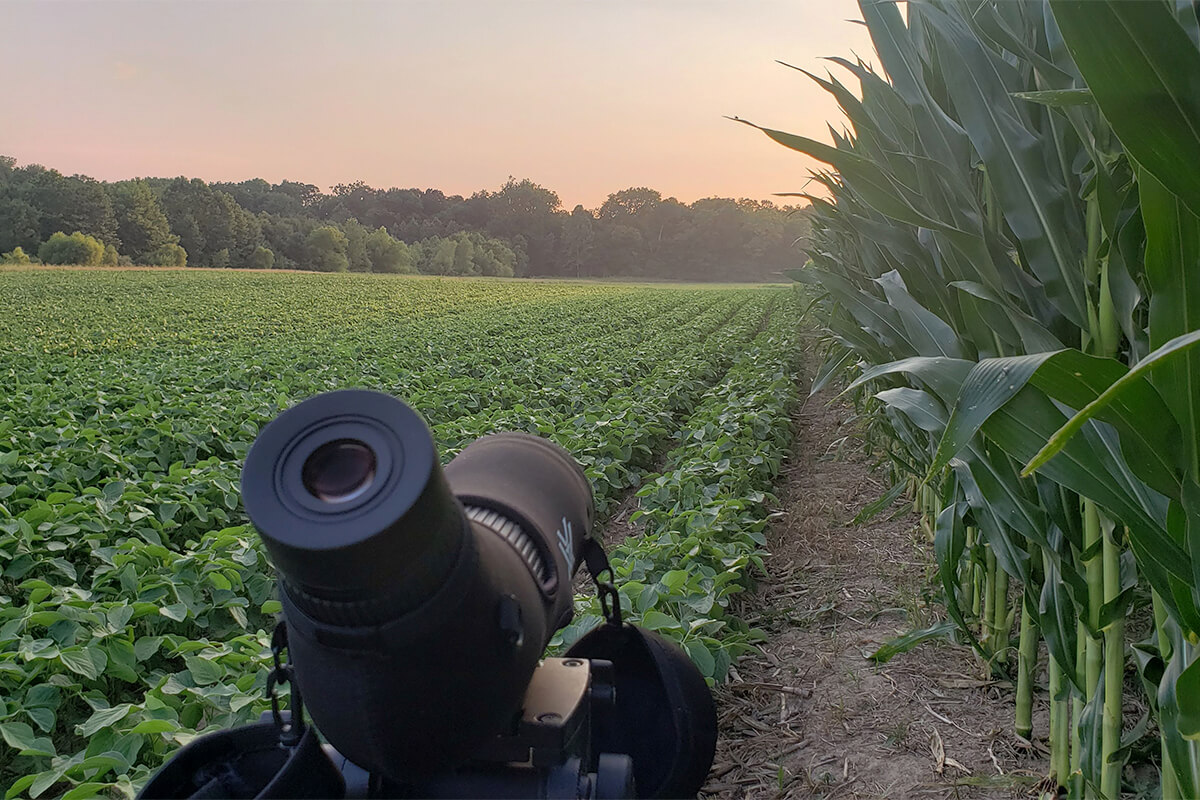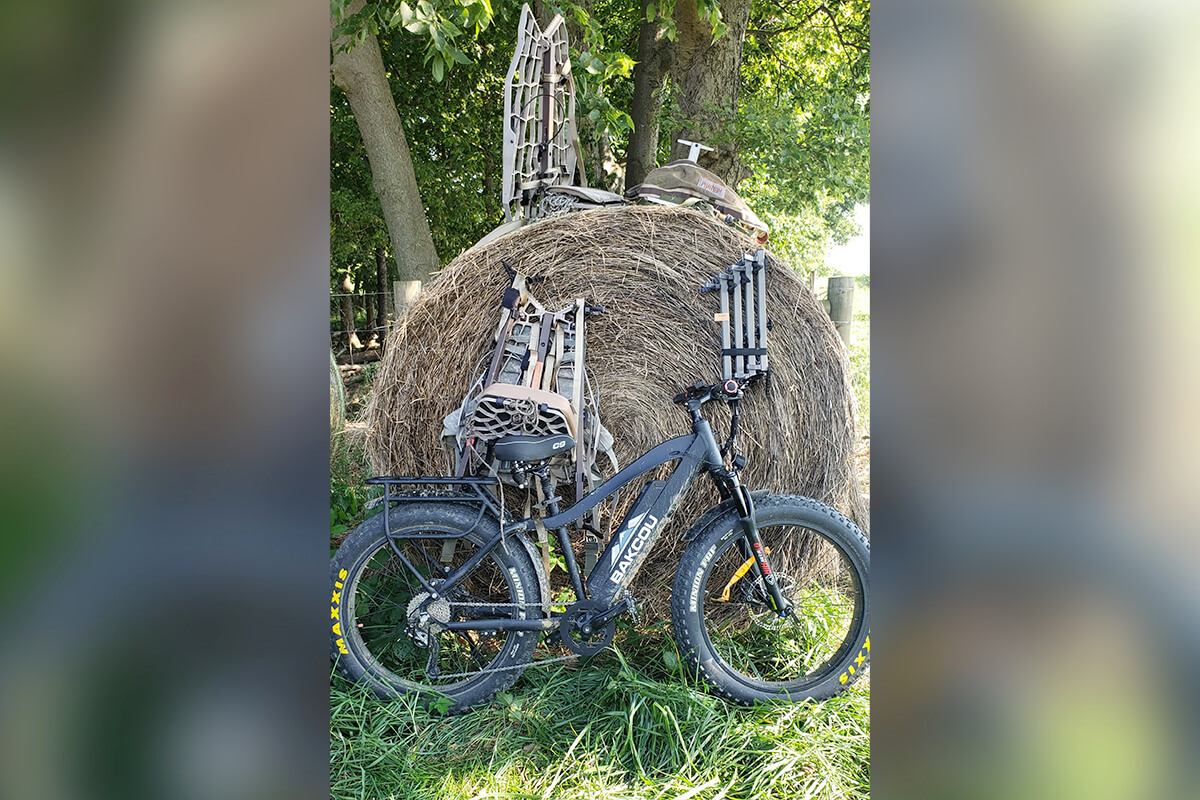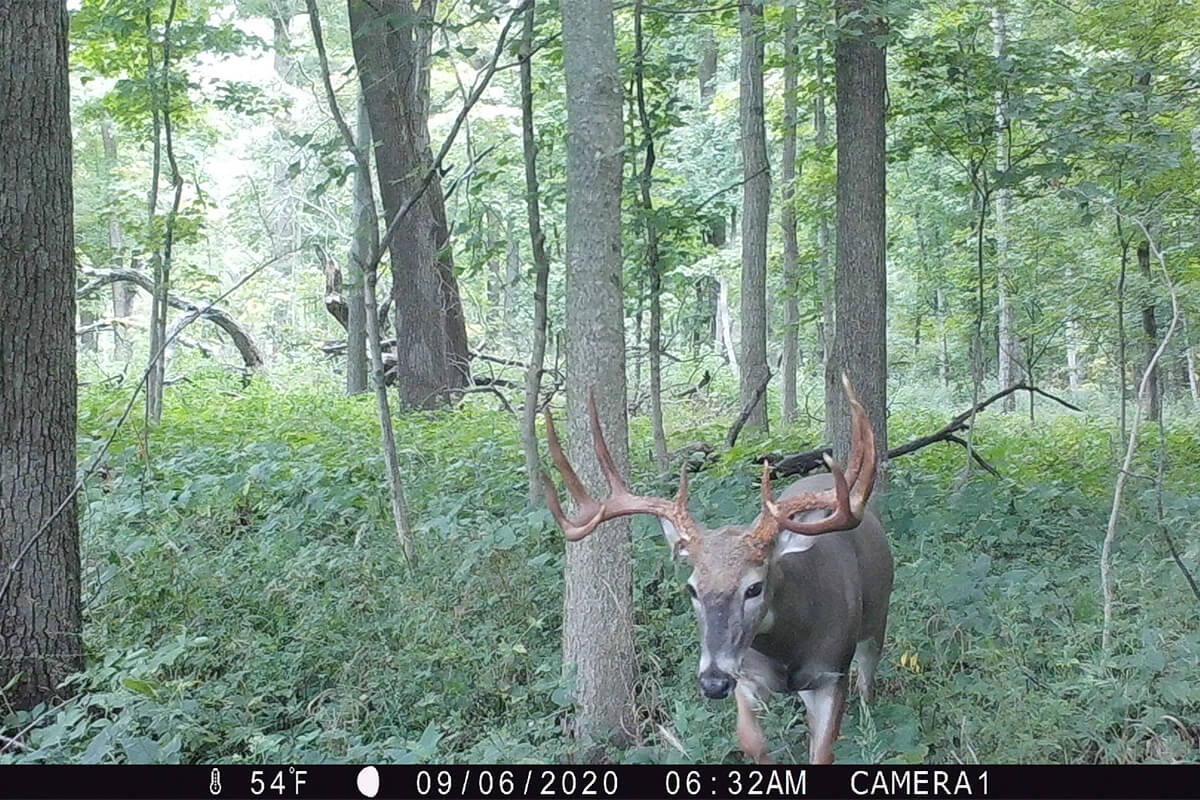
Those who put in the effort know that warm-season deer surveillance can reveal valuable intel about big buck habits and the intel gathered now can make fall hunting easier. (Photo by Clint McCoy)
Summer is full of things to do in one’s down time. Fishing, boating and golfing opportunities abound. Backyard barbecues and vacations with the family are likely. The summer season is often seen as a time to unwind and take it easy. But not for die hard whitetail enthusiasts.
For hunters seeking to fill their tags on mature, trophy caliber bucks, summer is full of toil and scouting effort. Loafing is not an option. During the humid doldrums of summer, seekers of quality trophy deer usually get their fill of heat, humidity, biting insects, poisonous plants and back breaking labor. Those that embrace the whitetail work in July and August usually fill their tags. Those that don’t usually see less predictable results.
In the summer of 2012, my scouting efforts were abysmal, as was the oppressive heat and drought we saw in the Midwest that year. I failed to take my summer deer work seriously, and consequently, I had the worst deer season I’ve ever had in 25 years of the pursuit. I got complacent and lazy with my output toward the upcoming fall.
Epizootic Hemorrhagic Disease (EHD) hammered my area of Illinois as well, and the combination of poor scouting effort and local deer die off cost me dearly that following fall. I didn’t fill a single buck tag, and I’ve never let myself live it down. Disgusted with the results, I changed my mindset toward summer whitetail work. I promised myself I’d never repeat that mistake and totally overhauled my summer scouting protocol.
Summer Scouting Goals
Setting the cornerstone for the foundation of my fall hunting season usually begins around July 4 and ends around Labor Day. Once I’m sitting in the stand come October, I want to be in the game from word go, having used the summertime for acquiring one thing: proof of life.
Some call it a “hit list” and others call it “inventory.” Before I try my hand at harvesting a trophy buck, I want to have PROOF that a mature buck exists in the areas I am hunting. Furthermore, I want knowledge about several mature bucks to pursue with tag in hand.
Doing this gives me other options in the Plan B Department. For instance, if a property suddenly gets timbered, sees an influx of other hunters, or if a certain buck prematurely meets his mortality, I like to have several other bucks to fall back on.
My priority for summer’s end is to have intimate, first-hand knowledge of as many shooter bucks as I can. And by then my hit list is usually 10 to 15 bucks deep. Likewise, if I’ve found a particular buck that really gets my attention, I’m going to spend a lot of time in those humid evenings spying on him.
Doing so allows me to go a step beyond simple proof of life. Persistent summer scouting can help build a series of behavioral profile traits and habits of a would-be wall-hanger. I want to know if a buck is a loner or a fighter or gregarious towards other deer. I want to see how he enters his feeding fields and how he acts out in the open. I also like to speculate where he might bed and where he gets his water. No detail here is insignificant when setting your sights for a mature buck.
I once heard a very successful and well-known whitetail hunter lament summer scouting deer, saying it puts too much pressure on deer and that the knowledge gained in the endeavor is useless, citing that after velvet peel, bucks sometimes shift to their fall range. This hunter called summer scouting “eye candy,” and said it was not applicable for hunting applications.
In my opinion, that’s hogwash. Having copious intel gathered using “pressure-light” scouting methods, all while anticipating the potential for a bucks’ range shift, is absolutely the most prepared way to enter deer season.
Summer Scouting Gear List
Summer whitetail effort doesn’t come easy. It’s hard work, and having the right equipment to get the job done as efficiently as possible is essential. Quality optics should be priority one. I use Vortex binoculars with their Viper spotting scope, paired with a tripod and small fluid head.
For elevated observation, I like to use a Tethrd Phantom tree saddle and their Predator platform with Novix mini sticks for long hikes in. Alternatively, I use a Lone Wolf Assault tree stand with full-size sticks. I might also simply hang an observation stand solely for summer use, and I’ll trim it out using a Wicked brand telescoping tree saw.
To capture images of the mature bucks I’m after, I really enjoy using a Phoneskope paired with my spotter and cell phone. For tail camera scouting, the Browning Strikeforce line is my workhorse model of choice, and for seated ground observation, Browning also offers a “Strutter” folding seat that really packs up nicely, allowing comfort and portability without a ton of weight.
A Thermacell and video camera round out my summer scouting day pack, making for a sound mobile spy kit. I upped the ante last summer and purchased a Bakcou e-bike and was thrilled with it (more on new e-bikes for scouting on pg. 16). The mobility of the bike certainly changed my summer scouting game for the better. I have several places I can access with the stealth of the bike every evening and never pressure the deer on exit when headed home at dark.

4 Best Summer Scouting Methods
What follows are my preferred strategies for warm-season whitetail scouting. I’ve found success with each method, and I use a combination of each frequently.
1: Gas and Glass Scouting
Step one is to get in vehicle. Step two is to drive around. Step three is to look at deer. It sounds pretty simple, and it is. Driving about your local hunting area in the evenings is a good starting place for getting basic deer inventory. It’s a quantity-over-quality thing here, and one can glass several big velvet deer on the fly over a large area. On the upside, you’re not sweating your tail off or getting eaten by mosquitos and buffalo gnats. The climate controlled truck cab is great! But this method can be a bit limited. In rolling terrain, for example, poor visibility of evening food sources where velvet bucks feed makes this method a less than ideal choice from the road. Likewise, I feel vehicle pressure is a deterrent to success. How many times do you think you can drive your 4×4 down a farm lane or pull over on a gravel road to glass a field before the mature bucks know you’re watching them? When scouting with the “gas and glass” method keep a low profile with your vehicle at all times.
2: Long Range Recon Scouting
One of my favorite summer scouting tricks is long range observation. I usually have a few predetermined locations where I can hike into. Once there, I sit in an inconspicuous patch of cover and bring a tripod with a spotting scope. A bulletproof entry and exit route can make these spots infinitely repeatable with respect to pressure. Usually, I’m overlooking shaded evening food source like soybeans or alfalfa. I’ve glassed long distances from Harvestore silos, grain bins and crude oil tanks. Old barns or pieces of farm equipment are also great low profile scouting positions. With long range sits, I rarely worry about wind direction and will get in position about two hours before last light.
3: Short Range Recon Scouting
For distances of observation inside 300 yards, one must get creative. Short range observation can yield some really great intel, and the velvet action can be phenomenal in these little shaded honey holes. When approaching these setups, I usually ride my e-bike in or have my wife drop me off and hike in early. I like to be very wind conscious, and I will use bulletproof entry and exit routes to get into position. I’ll walk through the humid, standing corn that butts up against a food source or use a patch of timber that has a nice creek system to travel in for concealment of my comings and goings. In tighter areas of distance, I prefer to hang from a tree saddle and use a set of climbing sticks. My optics here are a pair of 12×50 binoculars housed in a chest pack.
Now, this is usually hot work. You’ll sweat terribly, thus making odor control impossible and wind direction paramount. I’ll only do a few hanging observations during the summer and will space them out accordingly. I use them in areas I simply can’t see from longer ranges, and in areas where I need to take rapid inventory with as little intrusion as possible.

4: Summer Soak Scouting
In areas of standing corn, CRP or wooded timber, poor visibility forces me to scout via trail camera. I’ll place these in areas of interest, like water sources, shaded inside corners of standing corn and licking branches, and where allowed by law, mineral licks. I like to place my cameras out by July 4. I then pull the SD cards in September and sort through the photos. That allows me to be done in two low impact, pressure friendly trips. Repeated trail camera checks can burn a summer spot out, alerting the local deer herd of your presence with repeat exposure.
Take your time placing these long soak cameras, and clear brush, grass and other debris that may make for a bunch of triggers of useless images. Likewise, avoid “hot spots” where the sun may shine bright during the warm midday hours, giving the camera false triggers and more junk images. If you must check your cameras more often, do so during the hottest part of the day in bone dry conditions to help minimize bumping deer and stinking the place up. Lastly, a trail camera not in the field in the summer is a waste of a scouting resource. Get them out early, keep them out all summer, and you’ll be sifting through photos of red-coated velvet bucks in no time.

Just What the Doctor Ordered
My first long range observation mission in the summer of 2020 made my fall season. I rode my e-bike down a long winding farm lane to sit in the brush observing a very secluded, shady bean field. After I slipped down the corn rows to my hideout, I peeked out of the pollinating corn to see a tremendous mature buck feeding in the beans, working the shade line. The sight stopped me with a shudder, and as I got the binoculars to my eye, the buck lifted his head and revealed a big 10-point rack with a fine spread width.
In my best Doctor Emmett Brown, “Back to the Future” voice, I whispered to myself “Great Scott!” I was able to get into position and film this great buck for a long while that hot July evening, and I knew nothing about him before that date. I began putting a great deal of time and work observing this buck with the aforementioned summer scouting tricks. Eventually, I had gathered a plethora of photos, videos, map pins and field notes on the buck that became known to us as “Doctor Brown.”
The time I spent building a summer big buck profile of that deer made me fairly confident in my chances. On the opening day of our first shotgun season here in Illinois, I left the house on foot super early with a stand on my back. I hung it well before first light in a travel corridor the buck was known to frequent.
As fate would have it, Doc gave me a beautiful shot presentation, and the big 10-pointer dropped not 20 yards from my tree. The aftermath found me sitting next to a trophy buck that I’d taken great interest in during the previous summer. All those hot evenings in July and August truly made my season special!








